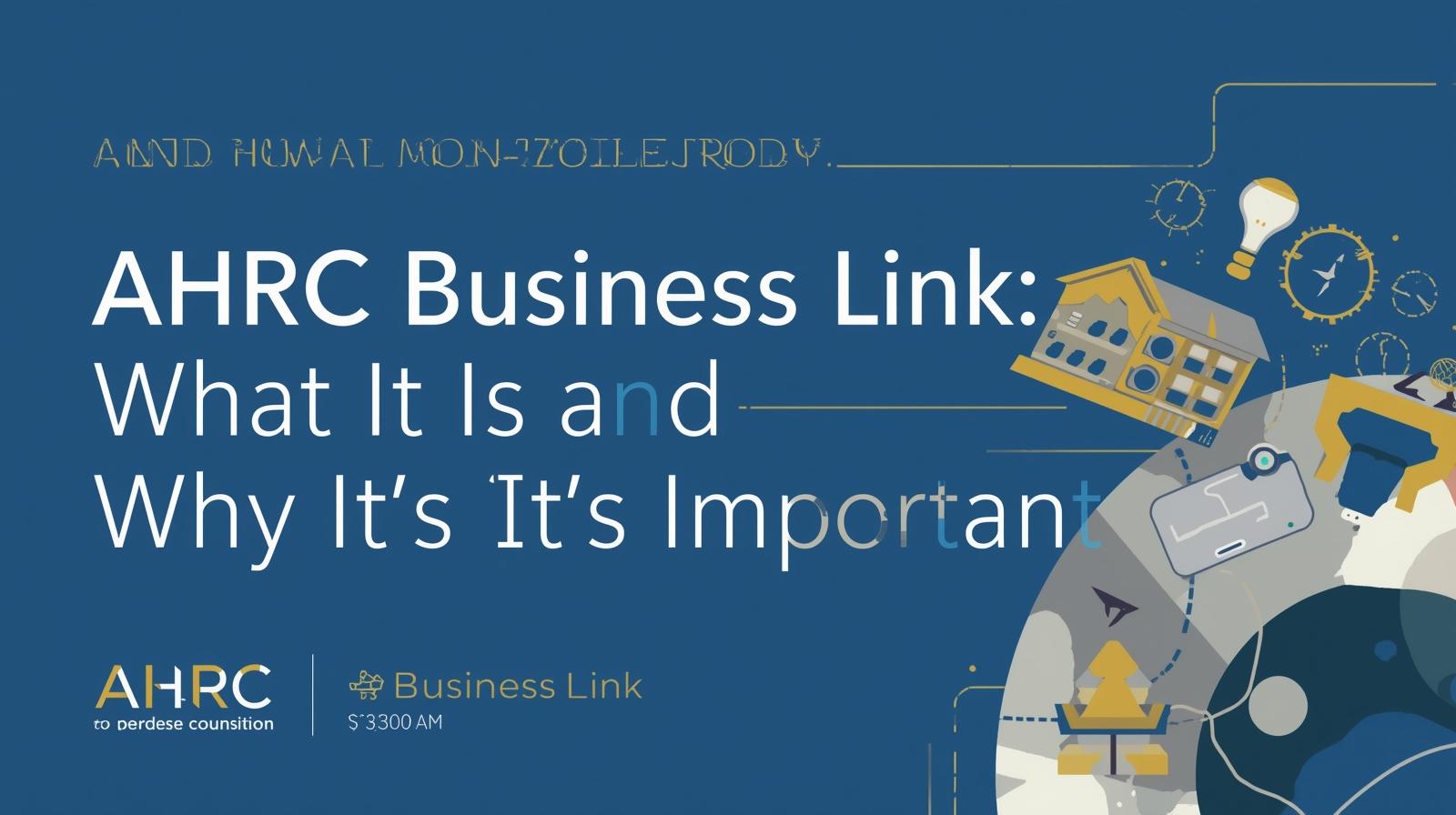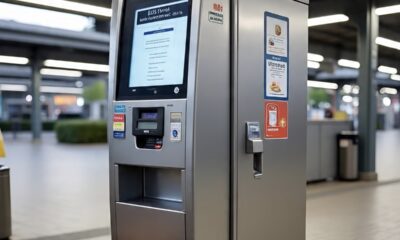Business
AHRC Business Link: What It Is and Why It’s Important
Published
2 weeks agoon

AHRC Business Link may sound like a specialized term, but at its core it refers to a centralized portal or system that connects various business, operational, human resources, and service tools within an AHRC organization (whether Nassau, NYC, or other chapters). On the AHRC Nassau website, there is a “Business Links” page listing key systems like the helpdesk, HR/payroll, clinic portal, and more.
In effect, AHRC Business Link acts as a digital hub a unified entry point for employees, administrators, partners, and stakeholders to access the multiple services, software, and support systems that AHRC uses. It simplifies navigation, centralizes resources, and reduces friction in daily operations.
Why this matters: as organizations grow and adopt more digital tools, the fragmentation becomes a burden. Having one portal (Business Link) means people don’t need to remember dozens of URLs or logins they can find everything in one place. It improves efficiency, reduces errors, and strengthens organizational cohesion.
The Components of an AHRC Business Link Portal
A well-designed Business Link portal typically includes:
- Helpdesk & Support Tools
For addressing IT issues, system outages, or general FAQs. For AHRC Nassau, “AHRC Helpdesk” is among the linked resources. - Email & Communication Platforms
Office 365 email, messaging systems, internal mail portals, etc. - HR / Payroll / Talent Management
Systems like UKG Pro (Payroll/HR) and iCIMS (talent management) are also linked via AHRC’s Business Links. - Operations & Workflow Tools
Tools like “eMaint” for work orders, document management (SpringCM), system access (Citrix), and internal portals. - Wellness / Employee Programs / Benefits
Access to wellness portals and employee support services via the same hub. - Training & Videos
Embedded training videos (e.g. PPE, system usage) accessible through that portal. - Special Services / Business Units
Under AHRC NYC, “AHRC NYC Businesses” include business arms like Superior Direct Care and Hudson River Services, which are part of the enterprise model and accessible through business service channels.
These components reflect how the Business Link portal is more than just IT it becomes the backbone of the internal digital ecosystem.
How AHRC Uses Business Link in Practice
To better understand how Business Link works in practice, let’s examine how AHRC (especially in NYC) leverages this portal and related business services:
Employment & Business Services in AHRC
AHRC New York City, in its “Employment & Business Services” section, promotes its business arms and staffing solutions. This includes offering no-cost staffing to employers, placing qualified workers through enterprise branches like Superior Direct Care and Hudson River Services.
That enterprise model ties back into Business Link because staff and partners need access to the systems that support those business arms payroll, scheduling, internal documents, performance tracking, etc.
Business Units under AHRC NYC
- Superior Direct Care Inc.: Provides staffing to group homes, programs, and community services under AHRC’s umbrella.
- Hudson River Services: Provides maintenance, janitorial, landscaping, floor care, and other contracted services in the New York area.
These enterprises function like subsidiaries but rely on the central AHRC infrastructure. Through Business Link, workers and managers can access the same core systems (HR, communication, operations) across these entities.
Integration Across AHRC Chapters
For AHRC Nassau, their “Business Links” page lists tools like helpdesk, email, payroll systems, media portals, and more. This shows that even separate chapters maintain parallel digital hubs.
Thus, Business Link becomes a shared strategy across regional branches a consistent portal model that supports decentralization but centralization of systems.
Benefits of Having an AHRC Business Link Portal
Implementing a robust Business Link portal brings multiple advantages:
Efficiency & Time Savings
Users no longer have to memorize or search for multiple URLs. One portal means one login (or federated login) and easy navigation. This cuts down on wasted time and frustration.
Better Onboarding & Training
New employees or partners can be directed to the Business Link portal for all the systems and documentation they need, streamlining onboarding.
Consistency & Governance
With one entry point, updates, system changes, or policy notices propagate uniformly. It’s easier for IT and administration teams to manage changes centrally.
Security & Access Control
Consolidation allows for better security protocols, single sign-on (SSO), role-based permissions, and auditing. Fewer entry points mean fewer vulnerabilities.
Scalability
As AHRC expands or adds new business units, those units can plug into the same portal infrastructure instead of building their own systems from scratch.
Better Support & Monitoring
Helpdesk logs, system usage metrics, and user behavior can be tracked more comprehensively because all tools flow through one portal.
Challenges & Considerations
While Business Link is powerful, implementing and maintaining it requires attention to a few challenges:
Integration Complexity
Bringing disparate systems (HR, payroll, operations, document management, wellness, etc.) into one unified portal can require custom development and careful API integration.
User Adoption
If staff members are used to separate systems, moving to one portal can lead to resistance. Training and change management are critical.
Access & Permission Management
Ensuring correct access levels, especially when business units have different functional requirements, demands robust permission systems.
Maintenance & Updates
The portal must be updated, deprecated systems handled, and new tools integrated continuously requiring ongoing investment.
Data Privacy & Compliance
Centralizing sensitive personal and business data in one hub raises privacy and regulatory considerations. Proper encryption, role isolation, data retention policies, and audits are essential.
How to Implement a Successful AHRC Business Link Portal
If an organization like AHRC wants to build or improve its Business Link portal, here’s a roadmap:
- Inventory Tools and Systems
Document all the systems currently used (HR, payroll, operations, helpdesk, etc.). Identify which need integration. - Define Roles and Access Levels
Plan who needs access to what. Staff, administrators, business managers, external partners each role with defined permission scopes. - Select a Portal Technology & SSO System
Choose a platform that supports SSO (single sign-on), modular integrations, and responsive design. - Integrate Core Systems via APIs
Link HR systems (like UKG Pro), document systems (SpringCM), communication tools, and operations tools to the portal backend. - UX & Design Focus
Make the portal intuitive. Use clear navigation, dashboards, and role-specific landing pages. - Migration & Onboarding
Migrate existing users with minimal disruption. Offer training sessions, documentation, and support. - Security & Compliance
Audit all data flows. Apply encryption, backup policies, access logs, and compliance standards (e.g. HIPAA, GDPR if applicable). - Feedback & Iteration
Continuously gather user feedback, monitor usage, and refine for performance, usability, and reliability.
Case Study: AHRC Nassau’s Business Links Page
As a concrete example, AHRC Nassau’s Business Links page lists many essential systems in one place:
- AHRC Helpdesk, Agency Email, Medisked, LogMeIn Rescue, HR systems, Clinic portals, maintenance systems, wellness program, and more.
- It also embeds training videos for staff (PPE, G-Tube training, etc.).
- The page is designed to serve staff across departments, helping them quickly reach core tools without digging through multiple websites.
This is a real-world example of Business Link in operation: providing a unified gateway to essential services.
The Future of Business Link Portals in Nonprofits and Agencies
Looking ahead, Business Link style portals will become essential in agencies and nonprofits. Some trends to expect:
- AI / Chatbot Assistants inside portals to help users faster (e.g. ask “How do I submit timesheet?”)
- Single Mobile App Versions of the portal for easier access on phones
- Analytics Dashboards for admins to see system usage, bottlenecks, and user behavior
- Third-Party Partner Integration for trusted external partners
- Adaptive / Role-Based Dashboards that show relevant tools first depending on role
- Continuous API Expansion so new tools can plug in seamlessly
Because organizations like AHRC have diverse services (residential, clinical, business arms, staff support), a strong portal backbone becomes an institutional asset, not just a convenience.
Final thoughts
AHRC Business Link is a powerful concept that transforms how organizations, especially complex nonprofits or agencies, manage their internal services and systems. By centralizing helpdesk support, HR, operations, and business arms into one unified portal, AHRC creates efficiency, coherence, and connectivity for staff and partners.
While integration, security, and adoption are valid challenges, the benefits reduced friction, streamlined workflows, better support, and scalability make Business Link portals a modern necessity.
If your organization is considering building or upgrading such a hub, the AHRC model offers a blueprint: centralize, simplify, secure, and continuously evolve.

A Start-Up with Patient Medical Stories

2 Story 2 Car Garage

100 Orange Juice Skip Opening Story

The Transformative Power of Technology in the Modern World

2 Year Mother’s Day Clothes: Adorable Styles to Celebrate the Day in Comfort and Joy

14th Century Clothing: A Detailed Look at Medieval Fashion and Style

Money Storm Slot Game: Where Every Spin Brings the Thrill of Fortune

Triple Double Diamond Free Games Slots: Classic Casino Fun with Big Wins

Best Running Trainers for Shin Splints: Find Comfort, Support, and Relief

Best Hair Products for Shine: Get That Healthy, Glossy Look Naturally

101 Warren Street New York City: Luxury Living in Tribeca

4 Seasons Nail Salon: A Place for Beauty, Relaxation, and Self-Care

10 Provost St Jersey City: A Complete Guide to Modern Living

2222 Jackson Ave Long Island City: A Modern Living Destination

6 Train Express Stops: A Complete Guide for New York City Commuters

Can You Get a Doctor’s Note Without Being Seen? A Complete Guide

Bella Donna Hair Salon: A Blend of Style, Elegance, and Care

Align Doctor Login Everything You Need to Know in Simple Words

Cutting Hair Style A Complete Guide to Modern Trends, Techniques, and Ideas

1920s Paris Business Women: The Bold Voices That Redefined Feminine Power

A Start-Up with Patient Medical Stories

2 Story 2 Car Garage

100 Orange Juice Skip Opening Story

The Transformative Power of Technology in the Modern World

2 Year Mother’s Day Clothes: Adorable Styles to Celebrate the Day in Comfort and Joy

14th Century Clothing: A Detailed Look at Medieval Fashion and Style

Money Storm Slot Game: Where Every Spin Brings the Thrill of Fortune

Triple Double Diamond Free Games Slots: Classic Casino Fun with Big Wins

Best Running Trainers for Shin Splints: Find Comfort, Support, and Relief









